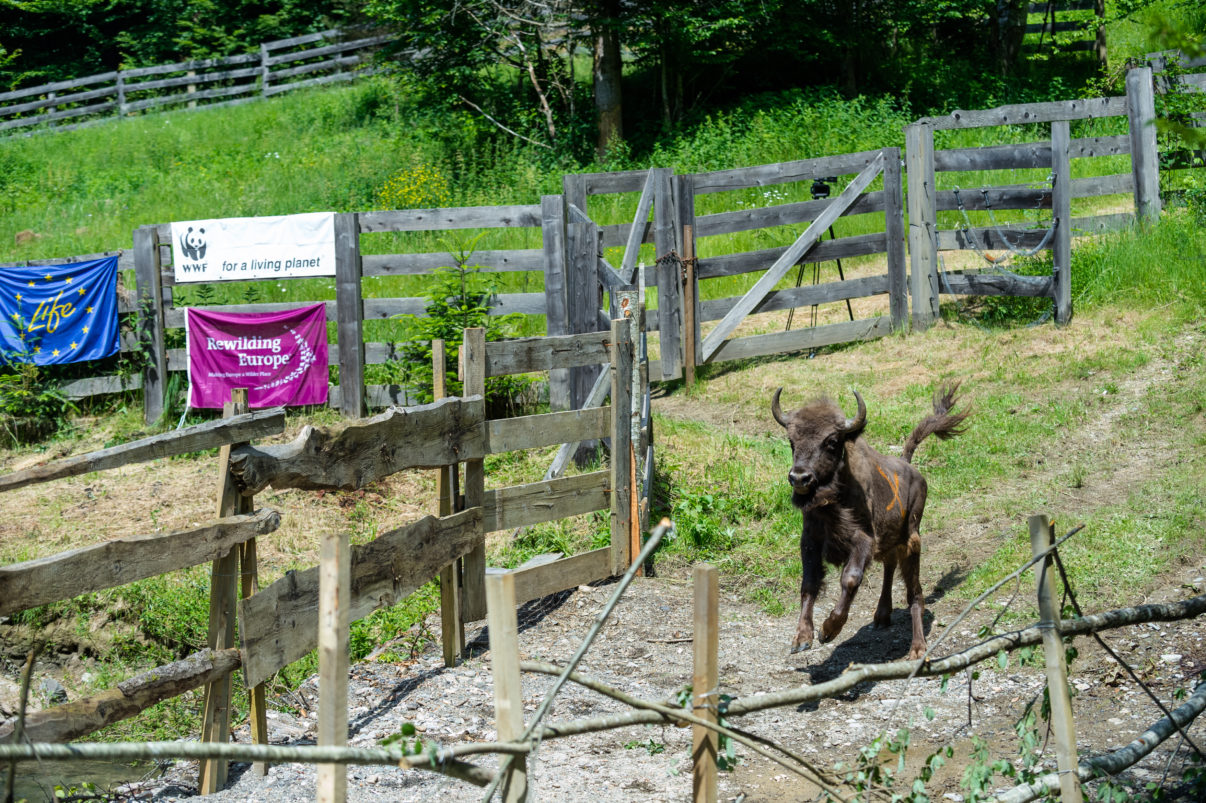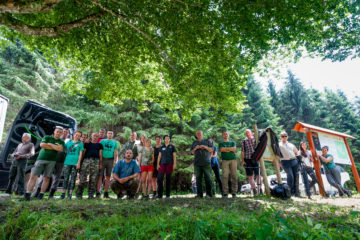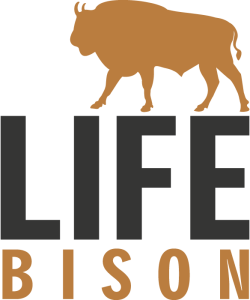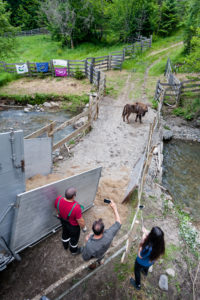The reintroduction of another European bison herd in the Southern Carpathians rewilding area continues efforts to establish a viable, free-roaming population of this keystone species. This will further increase the benefits to both wild nature and local communities.

Milestone moment
Rewilding Europe is delighted to announce the arrival of a new herd of bison at the Țarcu Mountains release site in the Southern Carpathians rewilding area.
Completed on June 20, the translocation of the seven-strong group of animals represents another milestone in the efforts of Rewilding Europe, WWF Romania and partners to establish a free-roaming and viable population of Europe’s largest land mammal in the Romanian Carpathians. This is not only positively impacting wild nature, but also bringing wide-ranging and long-lasting benefits to local communities.
“Wild European bison once roamed across Romania and Europe,” says Southern Carpathians rewilding team leader Marina Drugă. “With this release we have taken another step forward in the creation of a demographically and genetically viable population in the Carpathians, restoring these magnificent creatures to the habitats where they belong.”
Keystone impact
Including the latest release, 73 European bison have now been translocated into the Southern Carpathians rewilding area from nine different reserves, breeding centres and zoos across Europe. A total of around 50 animals currently roam freely at the area’s two release sites in the Țarcu and Poiana Ruscă Mountains.
As a so-called “keystone” species, the reintroduced bison are having an increasingly influential impact on their local environment. Through their grazing, wallowing, trampling and fertilising, the burgeoning bison herds create conditions that allow a diverse range of plant and animal species to thrive. They are also an important food source for predators such as wolves, lynx and bears.
Communities in the Southern Carpathians are also benefitting from the bison reintroduction. The goal of Rewilding Europe and WWF Romania is to work with wild nature – with a particular focus on the bison – to develop the region.
Today such development involves nature-based tourism, community-based and educational initiatives, scientific research and technological innovation. A large, free-roaming bison population is a big drawcard, complemented by the rewilding area’s rich local history and culture and stunning landscapes.
Rewilding process
The newly arrived bison herd, comprising five females (three from Springe, two from Edertal-Hemfurth) and two males (originally from breeders in Neumünster and Cuxhaven), travelled around 1500 kilometres from the Wisentgehege bison reserve in the German town of Springe near Hanover. Before their translocation the animals had spent six months together in the reserve, allowing them to form bonds that will help acclimatisation to their new home.
Despite the length of their journey, which took 21 hours, all the bison were pronounced healthy on arrival.
A bison named Curt II was the first to step on to Romanian soil, but was reluctant to explore further. To avoid an overly stressful situation developing for the remainder of the herd, the project manager decided to tranquilise and relocate him. The other six bison were quick to leave the truck, and soon the entire group – including Curt II – were happily grazing on fresh Romanian vegetation.
After spending their first 21 days in a relatively confined acclimatisation pen, they will be checked again by a veterinarian before relocation to a 160-hectare fenced area. Here they will be able to adapt to the local environment and learn to survive without human assistance.
Throughout the rewilding process bison rangers will constantly monitor the health and behaviour of the animals, using the data collected to better understand this keystone species. In the autumn the herd will finally become free roaming when they are released into the ȚarcuMountains, a dramatically beautiful Natura 2000 site extending across 59,000 hectares.
Record-breaking reintroduction
Once widespread across Europe, wild European bison were driven to extinction in the early twentieth century by hunting and habitat loss. Starting in 2014, the ongoing bison reintroduction programme by Rewilding Europe and WWF Romania is the largest ever attempted in the Southern Carpathians.
The first two bison releases took place in 2014 and 2015 in the Țarcu Mountains, close to the small town of Armeniș. In June 2016, a third bison release took place here as part of the European Commission-funded LIFE Bison project, with annual releases now ongoing. In 2018 another 23 bison were released into the wild, including 14 animals at a second rewilding site in the Poiana Ruscă Mountains.
The overall objective of the LIFE Bison project, which runs until December 2020, is to establish a wild bison population that is demographically and genetically viable in the Southern Carpathians. Subpopulations will be connected by corridors, enabling migration and genetic exchange.
Close collaboration

Rewilding Europe and WWF Romania collaborate closely with local communities at both bison release sites, with the involvement of local entrepreneurs, forest managers, hunting associations and tour operators ensuring the bison reintroduction programme has the best possible outcome.
An exhibition is now running at the second bison rewilding site (in the Densuș Tourist information centre) to raise the profile of the programme and highlight its main objectives. Following the arrival of the new bison herd the LIFE Bison project team will hold a meeting with local stakeholders to discuss human-wildlife coexistence and community development.
 Want to know / experience more?
Want to know / experience more?
- Learn more about Rewilding Europe’s work in the Southern Carpathians
- Learn more about the LIFE Bison project
- Track reintroduced bison in the Southern Carpathians with the European Safari Company
- Visit the Rewilding Southern Carpathians Facebook page

